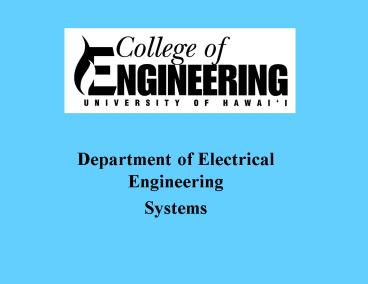Department of Electrical Engineering - PowerPoint PPT Presentation
1 / 17
Title:
Department of Electrical Engineering
Description:
Department of Electrical Engineering. Systems. What is Systems? ... H. Nyquist: engineer (stability of feedback amplifiers, sampling theorem) ... – PowerPoint PPT presentation
Number of Views:76
Avg rating:3.0/5.0
Title: Department of Electrical Engineering
1
- Department of Electrical Engineering
- Systems
2
What is Systems?
- The study of mathematical and engineering tools
used to analyze and implement engineering systems - Communications
- Networks
- SignalProcessing
- Control
3
History
- A. G. Bell scientist and inventor (telephone,
Bell Telephone Co., communication devices) - T. Edison inventor and businessman (electric
light bulb, power distribution systems, media
inventions) - H. Nyquist engineer (stability of feedback
amplifiers, sampling theorem) - C. Shannon EE and mathematician (information
theory, communications, sampling theorem) - J. Kilby EE ( inventor of IC, precursor for
development of signal processors and DSP)
4
Communications
- Transfer and organization of information, of
diverse media types and formats, through
communication networks and channels - IEEE Communications Society
5
Networks
- A computer network is a system for
communication among two or more computers. - Computer networks may be categorized with respect
to range - Computer network applications may be categorized
with respect to the functional relationships
between components - Computer networks may be categorized with respect
to network topologies - Computer networks may be categorized with respect
to specialized functions - Wikipedia
6
Signal Processing
- The theory and application of
- filtering, coding, transmitting, estimating,
detecting, analyzing, recognizing, synthesizing,
recording, and reproducing signals - by digital or analog devices or techniques.
- Signal" includes audio, video, speech, image,
communication, geophysical, sonar, radar,
medical, musical, and other signals - IEEE Signal Processing Society
7
Controls
- The theory, design and application of Control
Systems. - It shall encompass components, and the
integration of these components, as are necessary
for the construction of such systems. - The word systems' as used herein shall be
interpreted to include physical, biological,
organizational and other entities, and
combinations thereof, which can be represented
through a mathematical symbolism - IEEE Control Systems Society
8
EE Systems Curriculum
- Core EE Classes
- Tools Courses
- EE315 Signals and Systems
- EE342 Probability and Statistics
- EE341 Intro. to Communications
- Core Systems Classes
- EE351 Linear Systems and Control
- EE415 Digital Signal Processing
- Elective Classes
9
Signal Representation
Signals represent physical phenomena. Different
ways of representing information from a signal.
Time Domain
Frequency Domain
10
Signal Manipulation
System
y(t)
x(t)
- Signals manipulated by passing them through
systems - Filtering
- Estimation
- Coding
- Transmission
- Extraction
- Conversion
11
Analog to Digital Conversion
A/D
Digital Signal
Analog signal
Sampler
A/D
Continuous time Analog value
Discrete time Binary value
Discrete time Analog value
12
Analog and Digital Signals
13
Probability ApplicationRecovery of Information
Signals
Many physical processes modeled by random
phenomena
- x(t) is input signal containing information.
- y(t) is signal corrupted by random noise,
distortion from channel, and interference from
other information signals. - z(t) is output signal that gets estimate of
information x(t).
Channel
Receiver
x(t)
y(t)
z(t)
Receiver is designed using tools from
probability, systems, and communications to
optimize desired criteria (Signal to Noise Ratio,
Probability of error)
Noise
14
Digital Communications Systems
Source Encoder
Transmitter
Channel Encoder
Source
Channel
Source Decoder
Receiver
Channel Decoder
Destination
15
Multiplexing problem
FDM
TDM
CDM
Frequency
Frequency
Frequency
Time
Time
Time
Several information users share common channel.
How to multiplex information FDM analog signals,
optical fiber (WDM) TDM digital signals,
cellular phones CDM cellular phones, 3G
16
Jobs in Systems Area
- Telecommunications
- ATT, Cisco
- Defense
- Lockheed Martin, Boeing, Northrup Gruman,
Raytheon - Computers
- Microsoft, HP, Apple
- Electronics
- Motorola, Intel
- Startups
17
Homework Problem
- Pick one topic from below and use internet
resources to write a short report ( 1 to 2 pages)
on how systems technology will impact the
following areas - 3G communications
- Sensor networks
- Bioinformatics
- In your report please reference all web sites.
- Define topic and why it is important
- Key technological problems and how systems can
help - Key players in area
- Your interests in area































